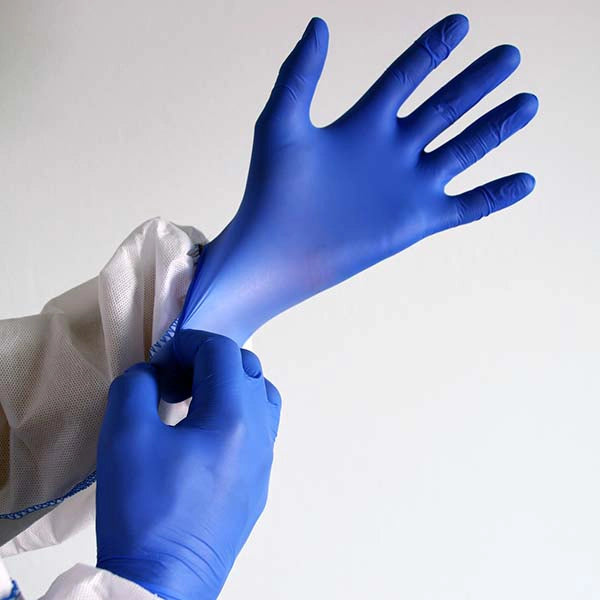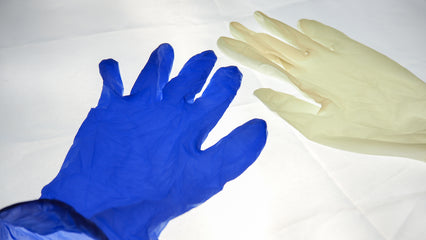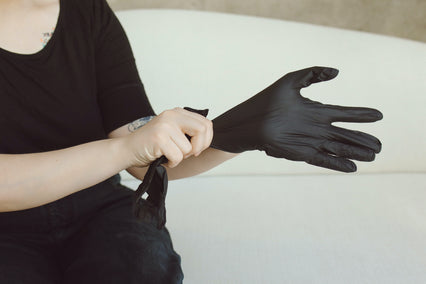
(Photo by RephiLe Water from Unsplash)
All types of gloves — both reusable and disposable gloves — are designed to protect the wearer and those around them from injuries, contaminations, and accidents. They are included in the must-wear protective equipment in many industries, such as healthcare, industrial, patient care, childcare, food, and more.
Just like wearing gloves, medical practitioners emphasized the importance of washing their hands and using alcohol or hand sanitizers. However, this is before wearing disposable gloves.
Can you use hand sanitizer on gloves you are currently wearing to disinfect or sanitize your gloves? Will the gloves' integrity be affected by hand sanitizer ingredients? Is this practice safe?
Find the answers and more with this guide! Let’s start the discussion.
How do hand sanitizers and gloves prevent the spread of germs and viruses?
Washing hands, using hand sanitizers, and wearing gloves are mandatory in hospitals, dental clinics, laboratories, and other health-related establishments. It is proven that regular and proper hand hygiene prevents the spread of types of germs, bacteria, and viruses. Also, it prevents direct contact with blood, body fluids, mucous membrane, and other liquids.
However, replacing gloves for every patient and washing their hands before wearing new ones is necessary. Wearing the same disposable gloves for all your patients without proper disinfection will lead to cross-contamination and the spread of various bacteria, germs, and viruses.
Hence, it is necessary to have proper hand hygiene, which includes using hand sanitizers, washing hands, and wearing disposable gloves.
How do hand sanitizers work?
Hand sanitizers work differently for viruses and bacteria.
For viruses like coronavirus, hand sanitizers disrupt or sabotage the virus's outer coat. Hand sanitizers are ineffective on viruses without the outer coat, such as norovirus, which leads to stomach flu. On the other hand, for bacteria, hand sanitizers go directly to the cell membrane and disrupt it.
However, not all hand sanitizers can do these for bacteria and viruses. Effective hand sanitizers should contain at least 60% rubbing alcohol. Washing hands with soap for at least 20 seconds is still the most effective way to prevent the spread of bacteria and viruses.
What is the Best Way to Sanitize Gloves?
Sanitizing gloves properly is crucial for maintaining a safe and hygienic environment, especially in medical and industrial settings. While it’s generally recommended to use disposable gloves and replace them frequently, there are situations where sanitizing gloves may be necessary.
Here are the best practices for sanitizing gloves:
Use Appropriate Sanitizing Agents
It’s essential to use sanitizing agents that are effective without degrading the glove material. For most glove types, including nitrile and latex, using alcohol-based hand sanitizers is not recommended as they can compromise the glove integrity. Instead, opt for sanitizing wipes or sprays that are specifically designed for use on gloves.
Follow Manufacturer Guidelines
Always adhere to the glove manufacturer’s guidelines for sanitization. Some manufacturers may recommend specific products or methods that are safe for their gloves. Using recommended products ensures that the gloves maintain their protective properties.
Avoid Harsh Chemicals
Harsh chemicals, including bleach and strong disinfectants, can degrade glove materials. If gloves are to be sanitized, choose mild disinfectants that are effective against pathogens but gentle on the glove material. Quaternary ammonium compounds are often a safe choice for sanitizing gloves without causing damage.
Proper Sanitization Technique
When sanitizing gloves, ensure thorough coverage. Apply the sanitizing agent evenly across the entire surface of the gloves, including the fingers and the spaces between them. Allow the sanitizing agent to remain on the gloves for the recommended contact time to effectively kill germs.
Advantages of Using Hand Sanitizers on Gloves
Hand sanitizers contain rubbing alcohol which can disinfect surfaces, hands, and gloves. If you have limited time, can’t wash your hands, or replace your gloves, disinfecting your gloves with hand sanitizers is inevitable. Here are the advantages of using hand sanitizers on gloves.
Prevent Potential Risk of Cross-Contamination
Since wearing sanitized disposable gloves in hospitals, clinics, laboratories, and other medical-related establishments is mandatory, wearing and replacing gloves for person to person has become a habit. However, there are instances where the users can’t afford to replace their gloves all the time. This is where hand sanitizers can help.
Using hand sanitizers on gloved hands is a must to prevent potential risks of cross-contamination or the spread of various bacteria, germs, and viruses.
Learn More About Medical Disposable Gloves: Medical and Industrial Grade Gloves: Is There a Difference?
Quick Disinfection
If you are running out of time and need to attend to a new patient quickly, hand sanitizers are a good option. However, washing your hands properly before wearing gloves and attending to another patient is still highly advised.
Save on Disposable Gloves
Due to the demand for disposable gloves and the number of patients entering hospitals, clinics, and laboratories, medical practitioners require a lot of disposable gloves. This can be expensive. By disinfecting gloved hands with hand sanitizers, you can save disposable gloves and use them in emergency cases.
Limitations of using hand sanitizers on gloves
Alcohol-based hand sanitizers are a convenient way to disinfect the skin. However, if used in a gloved hand, it can cause integrity problems with most disposable gloves. Hence, there are limitations to using hand sanitizers on gloves. Here are a few:
Types of Disposable Gloves
All types of disposable gloves develop tears, holes, or cracks when used for a long time. It might not be noticeable to the naked eye, but it happens. Hence, it is imperative to replace your gloves, especially if you are working in the medical field. Small holes can lead to contamination and the spread of viruses, bacteria, and germs.

Order Medical Grade Disposable Gloves Now!
Repeated exposure to hand sanitizers makes disposable gloves turn sticky and porous. Then, the bacteria, germs, and viruses can penetrate through, get in contact with your skin, and spread to your other patients.
Extreme Disposable Gloves Shortage
Due to the demand for disposable gloves, a shortage of disposable gloves is inevitable. In these cases, it is acceptable to disinfect disposable gloves using hand sanitizers.
Reusable Gloves
If you are using reusable gloves, proper washing and disinfection are a must. Check the manufacturer of your reusable gloves to identify what is the best way to clean and sanitize your safety gloves.
Safety tips for using hand sanitizers on gloves
If you can’t help but use hand sanitizers to disinfect gloves, here are a few safety tips to make sure you are properly sanitizing your gloves.
Wash Hands With Soap and Water
Washing hands with soap and water is the best way to prevent contamination and the spread of bacteria, germs, and viruses. Before wearing disposable gloves, always wash, dry, and clean your hands. This ensures your hands under the gloves are clean and sanitized. It also decreases the chances of cross-contamination coming from your own unwashed hands.
Cover Gloves With Hand Sanitizers
Don’t use small amounts of hand sanitizers. Cover and coat your gloved hands with alcohol-based hand sanitizer. This is more effective than a small droplet of hand sanitizer. Be generous when using hand sanitizers.
Spend Time Rubbing Gloved Hands With Hand Sanitizer
Spread hand sanitizers all over your gloved hands. Spend time massaging and rubbing the sanitizers in. Don’t forget in between fingers.
Let Hand Sanitizer Dry On Its Own
There is no need to wipe your gloved hands with a dry cloth or hand dryer. Alcohol-based hand rub evaporates. Let it dry on its own.
Don’t Apply Any Skin Care Products
Skin care products might contain ingredients that will cause the integrity of your gloves to deteriorate. Don’t apply any skin care products, like moisturizers and lotions, after sanitizing your gloves with hand sanitizers.
Replace Disposable Gloves
When your disposable gloves turn sticky, remove them, wash your hands with soap and water, dry them, and wear a new set of disposable gloves. Don’t sacrifice the safety of yourself and those around you.
Alternatives to Hand Sanitizers on Gloves
If you can’t afford to wear a new set of disposable gloves, you can disinfect your gloves with hand sanitizers. However, if you don’t have any alcohol-based hand sanitizers near you, you can use these two other alternatives to clean and sanitize your disposable gloves.
Soap And Water
Just like in sanitizing your hands, using soap and water is also an easy, affordable, and convenient way to clean and sanitize disposable gloves. High-quality and durable medical-grade disposable gloves can be washed up to 10 times.
However, the soap and water method is not suitable for short-cuffed disposable gloves. Soap and water can seep through the gloves and become trapped inside your gloves. This can lead to skin irritation and compromise the integrity of your disposable gloves.
Diluted Bleach Solution
This method can be used for long-cuffed gloves and is not advisable for short-cuffed gloves. Here’s how to use diluted bleach solution:
- While wearing the long-cuffed gloves, submerge gloved hands in the diluted bleach solution for 5 seconds. Make sure the solution doesn’t touch the skin.
- Remove hands from the solution and let the solution sit for 1 minute.
- In clean running water, rinse the diluted bleach solution.
- Using a clean, absorbent cloth, wipe your gloves dry.
- Check the integrity of the disposable gloves before meeting a new patient. If there is any discoloration, damage, or degradation, replace disposable gloves.
Recommendations for maintaining good hand hygiene
Proper hand washing is the key to maintaining good hand hygiene. Water and soap is still the best way to ensure your hands are clean and sanitized, especially in medical, food, or health-related establishments, tasks, and activities.
Cross-contamination is a huge risk in these industries. It is best to decrease the potential risks of contamination by regularly washing your hands. Also, dry your hands before wearing disposable gloves.
By having good hand hygiene and regular hand washing, you can protect yourself, your loved ones, and the people around you from getting infected by bacteria, germs, and viruses.
Final thoughts on using hand sanitizers on gloves
Wearing disposable gloves is necessary for most health, medical, food, and other industries. However, there are instances when you need to sanitize your gloved hands in crucial or critical moments like emergencies. Hence, using hand sanitizers on gloved hands can be beneficial for you.
In addition, if there are limited disposable gloves around you, the use of hand sanitizers can help you. However, it is still advisable to wash your hands and replace your disposable gloves after every patient or task. This is to prevent any contamination or spread of diseases.
Nothing beats proper hand washing and replacing your gloves!
Check the Best Gloves at gloves.com
For all your high-quality disposable gloves needs, visit gloves.com. Browse through our extensive collection of disposable gloves today.
We have latex gloves, nitrile gloves, vinyl gloves, and other types of gloves all sourced from reputable manufacturers and brands. All our gloves are available in different sizes. Choose the perfect disposable gloves based on your needs, preferences, applications, and usage.
Hand Sanitizer on Gloves: Frequently Asked Questions
Can you use alcohol rub on gloves?
Using alcohol rub on gloves is not recommended. Alcohol can degrade the glove material, especially latex and nitrile, compromising their integrity and reducing their effectiveness as a barrier. It’s better to change gloves when they become contaminated rather than attempting to sanitize them with alcohol rub.
Does hand sanitizer make gloves sticky?
Yes, using hand sanitizer on gloves can make them sticky. The ingredients in hand sanitizers, particularly those with high alcohol content, can interact with the glove material, causing them to become tacky or sticky. This not only makes the gloves uncomfortable to wear but can also reduce their protective qualities.
Can I use sanitizer instead of rubbing alcohol?
Hand sanitizer and rubbing alcohol serve different purposes. Hand sanitizers are designed to kill germs on the skin and usually contain additional ingredients like moisturizers to prevent skin dryness. Rubbing alcohol (isopropyl alcohol) is a more potent disinfectant used for cleaning surfaces and medical instruments. While hand sanitizer can be used for quick hand disinfection, it is not a direct substitute for rubbing alcohol, especially when a stronger disinfectant is needed for surfaces or equipment.





